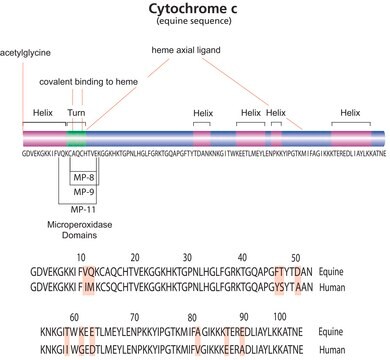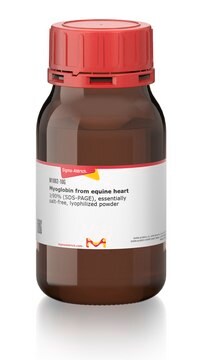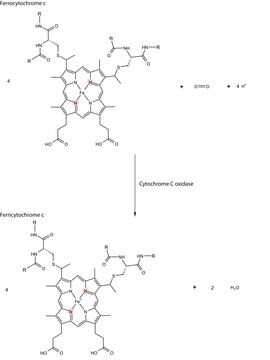C2867
Citocromo c
BioUltra, ≥99% (SDS-PAGE), powder, suitable for mammalian cell culture
Sinonimo/i:
Citocromo c
About This Item
Prodotti consigliati
Origine biologica
horse heart
Nome Commerciale
BioUltra
Saggio
≥99% (SDS-PAGE)
Forma fisica
powder
PM
12,384
Condizioni di stoccaggio
(Tightly closed Dry)
tecniche
cell culture | mammalian: suitable
Solubilità
water: 10 mg/mL, dark red-brown
N° accesso UniProt
Temperatura di conservazione
−20°C
Informazioni sul gene
horse ... CYCS(100053958)
Cerchi prodotti simili? Visita Guida al confronto tra prodotti
Categorie correlate
Descrizione generale
Research area: Apoptosis
Applicazioni
Azioni biochim/fisiol
Nota sulla preparazione
Altre note
Applicazioni
Codice della classe di stoccaggio
11 - Combustible Solids
Classe di pericolosità dell'acqua (WGK)
WGK 3
Punto d’infiammabilità (°F)
Not applicable
Punto d’infiammabilità (°C)
Not applicable
Dispositivi di protezione individuale
Eyeshields, Gloves, type N95 (US)
Certificati d'analisi (COA)
Cerca il Certificati d'analisi (COA) digitando il numero di lotto/batch corrispondente. I numeri di lotto o di batch sono stampati sull'etichetta dei prodotti dopo la parola ‘Lotto’ o ‘Batch’.
Possiedi già questo prodotto?
I documenti relativi ai prodotti acquistati recentemente sono disponibili nell’Archivio dei documenti.
I clienti hanno visto anche
Articoli
Learn about the four membrane-bound protein complexes that make up the electron transport chain metabolic pathway supplying energy as ATP for cellular respiration.
Chromatograms
application for HPLCapplication for HPLCapplication for HPLCIl team dei nostri ricercatori vanta grande esperienza in tutte le aree della ricerca quali Life Science, scienza dei materiali, sintesi chimica, cromatografia, discipline analitiche, ecc..
Contatta l'Assistenza Tecnica.







